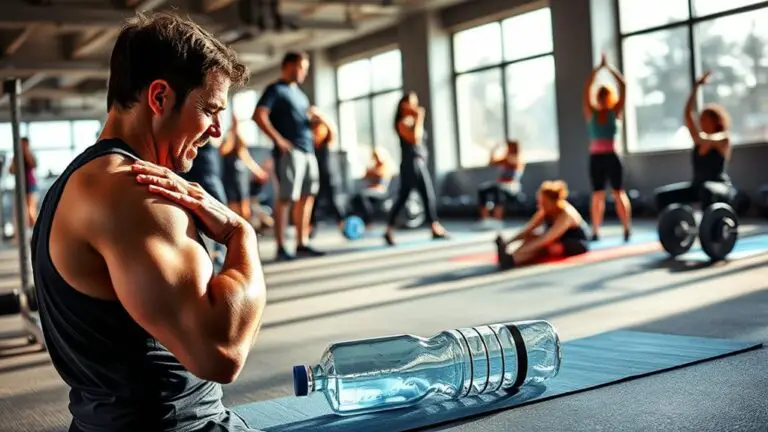How to Prevent Overuse Injuries With Gym Training

To prevent overuse injuries in gym training, focus on balancing your workout intensity and volume. Incorporate adequate rest and recovery days to allow your muscles to rebuild. Gradually increase workout intensity by no more than 10% per week. Make certain you maintain proper form and technique during exercises to minimize strain. Engaging in cross-training can enhance muscle development while reducing injury risk. Listen to your body’s signals for signs of fatigue or discomfort—there’s more to take into account for safe training.
Understand the Basics of Overuse Injuries

When you engage in gym training, it’s important to understand the basics of overuse injuries, as they can greatly hinder your progress and lead to long-term consequences. Overuse injuries refer to a range of conditions resulting from repetitive stress on muscles, tendons, and joints without adequate recovery. Common examples include tendinitis, stress fractures, and bursitis. Recognizing the signs early can be significant for injury prevention; symptoms like persistent pain, swelling, or decreased performance should not be ignored.
To avoid these injuries, it’s crucial to balance your training intensity and volume with proper technique and adequate rest. Gradually increasing your workload allows your body to adapt without succumbing to overuse. Additionally, incorporating cross-training can help distribute the physical demands on your body, reducing the risk of injury. By understanding these overuse definitions and implementing effective strategies, you can maintain your gym training regimen safely and effectively.
Incorporate Rest and Recovery Days
Incorporating rest and recovery days into your training regimen is essential for preventing overuse injuries. If you’re experiencing persistent fatigue, muscle soreness, or decreased performance, these may be signs that your body needs time to recuperate. Prioritizing recovery not only enhances your overall performance but also reduces the risk of injury.
Importance of Rest Days
Rest days play a crucial role in any effective gym training regimen, as they allow your muscles to recover and rebuild after intense workouts. Incorporating rest days not only aids in physical recovery but also provides mental rejuvenation, enhancing your overall performance. Engaging in active recovery—such as light walking or stretching—can further help maintain your fitness levels while promoting healing.
| Day | Activity | Benefits |
|---|---|---|
| Rest Day 1 | Gentle yoga | Flexibility and relaxation |
| Rest Day 2 | Light walking | Improved circulation |
| Rest Day 3 | Swimming | Low-impact muscle engagement |
| Rest Day 4 | Foam rolling | Muscle tension relief |
Signs You Need Recovery
Recognizing the signs your body needs recovery is essential to preventing overuse injuries and maintaining long-term fitness. Key recovery signs include persistent muscle soreness, decreased performance, and increased irritability. If you’re feeling unusually fatigued, that’s a critical fatigue indicator suggesting your body requires rest. You might also notice changes in sleep patterns or elevated heart rates during workouts, both of which indicate your body is struggling to recover. Ignoring these symptoms can lead to serious injuries, undermining your fitness goals. Incorporating regular rest and recovery days into your training regimen can help mitigate these risks, ensuring you’re in ideal condition for your next workout session. Listen to your body—it’s the best guide for effective training.
Gradually Increase Workout Intensity

As you commence your gym training journey, it is crucial to gradually increase workout intensity to minimize the risk of overuse injuries. This principle, known as progressive overload, involves systematically enhancing the demands placed on your body. Start by familiarizing yourself with the current intensity of your workouts, including weights, repetitions, and duration.
Incorporating workout variations can also help you avoid overuse injuries. By changing exercises, you can target different muscle groups and reduce repetitive strain on specific areas. For example, if you’re focusing on squats, consider integrating lunges or step-ups into your routine. Aim to increase intensity incrementally—whether that’s adding weight, increasing reps, or extending cardio duration—no more than 10% per week. Monitoring your personal benchmarks can help you assess your progress and ensure that you are challenging yourself appropriately.
Focus on Proper Form and Technique
Proper form and technique are essential pillars of effective gym training, greatly reducing the risk of overuse injuries. By prioritizing correct execution, you not only enhance performance but also safeguard your body from unnecessary strain. Regular form assessments can help identify areas for improvement, while technique drills can refine your skills. Here are key strategies to take into account:
- Always warm up to prepare your muscles.
- Use mirrors or video to analyze your form.
- Seek professional guidance for personalized feedback.
- Incorporate technique drills specific to each exercise.
- Gradually increase complexity once your form is consistent.
Additionally, understanding how to maintain a comfortable rhythm during workouts can further enhance your training experience. Implementing these practices guarantees you develop a solid foundation, minimizing the likelihood of injuries. Remember, it’s not just about lifting heavier; it’s about lifting correctly. Focus on form and technique, and your body will thank you in the long run.
Cross-Train for Balanced Muscle Development

When you incorporate cross-training into your fitness routine, you not only enhance overall muscle development but also reduce the risk of overuse injuries. By engaging in balanced workouts that target different muscle groups, you guarantee muscle variety, which plays a vital role in preventing strain and fatigue in specific areas. For example, alternating between weightlifting, cycling, swimming, and yoga allows your body to recover while still maintaining an active regimen. This approach can include low impact alternatives like exercise bands, which provide a full-body workout without putting excessive stress on your joints.
This approach helps to develop complementary muscles, improving strength and flexibility throughout your body. Additionally, cross-training can enhance your cardiovascular fitness, further supporting your overall health. By diversifying your training, you also keep your routine fresh and enjoyable, which can enhance motivation and adherence. Remember, the goal of cross-training isn’t just to build muscle but to create a well-rounded fitness profile that minimizes the risk of injury while maximizing performance.
Listen to Your Body’s Signals
Listening to your body’s signals is vital in preventing overuse injuries. Recognizing pain signals is essential; ignoring them can lead to severe damage and prolonged recovery times. Additionally, prioritizing rest and recovery allows your body to heal and adapt, ultimately enhancing your performance in the gym.
Recognize Pain Signals
How can you effectively distinguish between normal discomfort and a potential injury during your gym training? Understanding your pain threshold is essential for injury prevention. Pay attention to your body’s signals, as they can indicate when something’s wrong.
- Localized Pain: Sharp or specific pain could signify an injury.
- Persistent Discomfort: If pain lingers beyond your workout, it may be a warning.
- Swelling or Inflammation: This is often a sign of overuse.
- Decreased Performance: Struggling to lift weights or complete workouts can indicate an issue.
- Altered Movement: Compensating for pain can lead to further injuries.
Listening to your body is fundamental for maintaining a safe and effective training regimen.
Rest and Recovery Importance
Recognizing the signals your body sends is only the beginning; incorporating adequate rest and recovery is essential for long-term success in gym training. Your muscles need time to repair and strengthen, and neglecting rest can lead to overuse injuries. Active recovery, such as light activities like walking or yoga, promotes blood circulation, aiding in muscle recovery without causing additional strain. In addition, sleep importance cannot be overstated; quality sleep is vital for muscle recovery and hormonal balance. Aim for 7-9 hours of uninterrupted sleep per night to optimize your recovery process. By listening to your body and prioritizing rest, you not only enhance your performance but also reduce the risk of injuries that can sidetrack your fitness journey.
Consult With a Fitness Professional

Consulting with a fitness professional can greatly reduce the risk of overuse injuries during gym training. These experts help you understand your body better through extensive fitness assessments, ensuring that your training is both safe and effective. By developing personalized programs tailored to your specific needs, they can help you avoid repetitive strain and other common injuries.
Consider the following benefits of working with a fitness professional:
- Conducting thorough fitness assessments to identify strengths and weaknesses
- Creating personalized programs that address your unique goals
- Teaching proper techniques to prevent strain and injury
- Monitoring your progress and adjusting your program as needed
- Offering guidance on rest and recovery strategies
Incorporating their expertise into your training routine can enhance your performance while minimizing the potential for overuse injuries. Remember, investing in professional guidance can lead to safer and more effective workouts. Additionally, they emphasize the importance of listening to your body to prevent injuries and ensure a sustainable training regimen.
Frequently Asked Questions
What Are Common Symptoms of Overuse Injuries to Watch For?
When considering common symptoms of overuse injuries, it’s essential to recognize pain signals your body sends. You might notice persistent aches or sharp pain during or after activity, swelling in specific areas, or a decrease in strength and flexibility. These injury signs can develop gradually, making it easy to overlook them. Pay attention to any unusual sensations or prolonged discomfort, as they may indicate the need for rest and reevaluation of your training routine.
How Can I Tell if I Need More Rest Days?
Did you know that nearly 50% of athletes experience overuse injuries due to inadequate rest? To determine if you need more rest days, pay attention to rest day indicators like persistent fatigue, decreased performance, and lingering soreness. If your training intensity feels consistently high without recovery, it’s a sign you might be pushing too hard. Prioritize listening to your body; sufficient rest is essential for peak performance and injury prevention.
What Types of Cross-Training Are Most Effective?
When considering effective cross-training options, you should focus on incorporating both strength training and aerobic activities. Strength training helps build muscle resilience, while aerobic activities enhance cardiovascular fitness and endurance. Options like swimming, cycling, or rowing can provide a low-impact alternative to running, reducing the risk of overuse injuries. Balancing these types of exercises in your regimen not only improves overall performance but also aids in recovery and injury prevention.
Can Overuse Injuries Occur in Beginners as Well?
Yes, overuse injuries can definitely occur in beginners. When you push your body too hard without proper recovery, you risk developing overtraining syndrome. It’s vital to follow beginner guidelines, such as gradually increasing intensity and allowing adequate rest days. This helps your body adapt and reduces the likelihood of injuries. Remember, taking the time to build a solid foundation is essential for long-term success and injury prevention in your training journey.
Are There Specific Stretches to Prevent Overuse Injuries?
You might think stretching’s just a casual warm-up, but it’s the secret weapon against those pesky overuse injuries. Incorporating dynamic stretching before workouts gets your muscles primed and ready, while static stretching afterward helps maintain flexibility. Focus on key areas like hamstrings, quads, and shoulders. By blending both techniques, you’re not just preventing injuries; you’re building a robust foundation for your fitness journey. Remember, your body deserves the best care!





